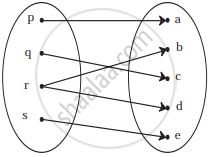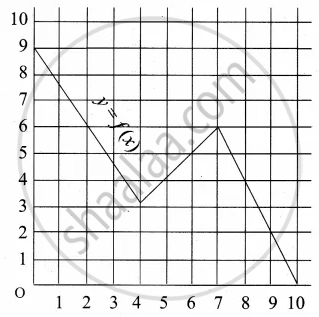Advertisements
Advertisements
प्रश्न
Write the domain and range of function f(x) given by \[f\left( x \right) = \sqrt{\left[ x \right] - x}\] .
उत्तर
\[\text{ We know that } \]
\[[x] - x = - {x}, \text{ which is the fractional part of any real number x } . \]
\[\text{ Thus } , f(x) = \sqrt{- {x}} . \]
\[\text{ Since {x} is always a positive number, f(x) is not defined for any x . } \]
\[\text{ Or dom } (f) = \varphi\]
\[\text{ Thus, range } (f) = \varphi . \]
APPEARS IN
संबंधित प्रश्न
Define a function as a correspondence between two sets.
What is the fundamental difference between a relation and a function? Is every relation a function?
Let A = {−2, −1, 0, 1, 2} and f : A → Z be a function defined by f(x) = x2 − 2x − 3. Find:
(a) range of f, i.e. f(A).
Let f : R → R and g : C → C be two functions defined as f(x) = x2 and g(x) = x2. Are they equal functions?
Let X = {1, 2, 3, 4} and Y = {1, 5, 9, 11, 15, 16}
Determine which of the set are functions from X to Y.
(b) f2 = {(1, 1), (2, 7), (3, 5)}
Let X = {1, 2, 3, 4} and Y = {1, 5, 9, 11, 15, 16}
Determine which of the set are functions from X to Y.
(c) f3 = {(1, 5), (2, 9), (3, 1), (4, 5), (2, 11)}
If f(x) = x2, find \[\frac{f\left( 1 . 1 \right) - f\left( 1 \right)}{\left( 1 . 1 \right) - 1}\]
If \[f\left( x \right) = \frac{1}{1 - x}\] , show that f[f[f(x)]] = x.
Let f(x) = x2 and g(x) = 2x+ 1 be two real functions. Find (f + g) (x), (f − g) (x), (fg) (x) and \[\left( \frac{f}{g} \right) \left( x \right)\] .
If f : Q → Q is defined as f(x) = x2, then f−1 (9) is equal to
The domain of the function
The range of the function f(x) = |x − 1| is
Check if the following relation is function:

Find the domain and range of the following function.
f(x) = 7x2 + 4x − 1
Express the area A of circle as a function of its radius r
Express the following exponential equation in logarithmic form
`9^(3/2)` = 27
Express the following exponential equation in logarithmic form
3–4 = `1/81`
Express the following exponential equation in logarithmic form
e2 = 7.3890
If f(x) = ax2 − bx + 6 and f(2) = 3 and f(4) = 30, find a and b
If x = loga bc, y = logb ca, z = logc ab then prove that `1/(1 + x) + 1/(1 + y) + 1/(1 + z)` = 1
Select the correct answer from given alternative.
The domain and range of f(x) = 2 − |x − 5| is
Answer the following:
Identify the following relation is the function? If it is a function determine its domain and range.
{(0, 0), (1, 1), (1, –1), (4, 2), (4, –2), (9, 3), (9, –3), (16, 4), (16, –4)}
Answer the following:
Find whether the following function is one-one
f : R → R defined by f(x) = x2 + 5
Answer the following:
Simplify, log (log x4) – log (log x)
Answer the following:
Simplify `log_10 28/45 - log_10 35/324 + log_10 325/432 - log_10 13/15`
Answer the following:
If `log (("a" + "b")/2) = 1/2(log"a" + log"b")`, then show that a = b
Answer the following:
If a2 = b3 = c4 = d5, show that loga bcd = `47/30`
Answer the following:
Find the range of the following function.
f(x) = 1 + 2x + 4x
Answer the following:
Find (f ° g) (x) and (g ° f) (x)
f(x) = `x/(x + 1)`, g(x) = `x/(1 - x)`
A graph representing the function f(x) is given in it is clear that f(9) = 2

For what value of x is f(x) = 1?
A graph representing the function f(x) is given in it is clear that f(9) = 2

Describe the following Range
Domain of function f(x) = cos–1 6x is ______.
Redefine the function which is given by f(x) = `|x - 1| + |1 + x|, -2 ≤ x ≤ 2`
The domain and range of real function f defined by f(x) = `sqrt(x - 1)` is given by ______.
The domain of the function f given by f(x) = `(x^2 + 2x + 1)/(x^2 - x - 6)` is ______.
The domain for which the functions defined by f(x) = 3x2 – 1 and g(x) = 3 + x are equal is ______.
The value of the function f(x) = `(x^2 - 3x + 2)/(x^2 + x - 6)` lies in the interval
Let f(x) and g(x) be two real polynomials of degree 2 and 1 respectively. If f(g(x)) = 8x2 – 2x, and g(f(x)) = 4x2 + 6x + 1, then the value of f(2) + g(2) is ______.
If f : R – {2} `rightarrow` R i s a function defined by f(x) = `(x^2 - 4)/(x - 2)`, then its range is ______.
Range of the function f(x) = `x/(1 + x^2)` is ______.
